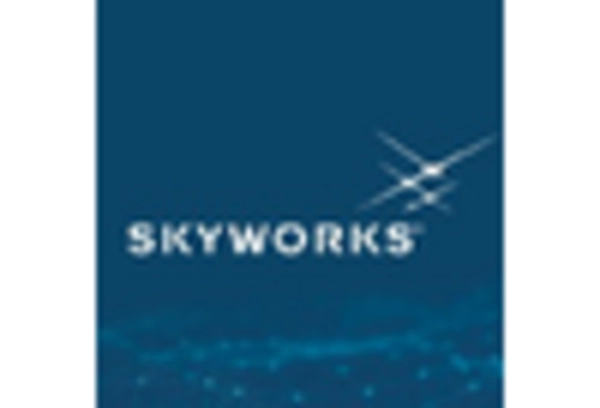Growth of Automotive Applications
The RF Front End Module Market is witnessing substantial growth driven by the increasing integration of RF technologies in automotive applications. With the rise of connected vehicles and advanced driver-assistance systems (ADAS), the demand for reliable RF front end modules is on the rise. These modules are essential for enabling vehicle-to-everything (V2X) communication, which enhances safety and efficiency on the roads. The automotive RF market is anticipated to reach USD 5 billion by 2026, indicating a robust growth potential. As automotive manufacturers continue to innovate and incorporate more sophisticated RF technologies, the RF Front End Module Market is likely to benefit from this trend, positioning itself as a critical component in the future of automotive technology.
Emergence of Smart Devices and IoT
The emergence of smart devices and the Internet of Things (IoT) is significantly impacting the RF Front End Module Market. As more devices become interconnected, the demand for efficient RF front end modules that can facilitate seamless communication is growing. The IoT market is expected to reach USD 1.1 trillion by 2026, highlighting the vast potential for RF technologies in this sector. Smart home devices, wearables, and industrial IoT applications are driving the need for compact and high-performance RF front end modules. This trend suggests that the RF Front End Module Market will continue to expand as manufacturers seek to develop innovative solutions that cater to the evolving needs of consumers and businesses in an increasingly connected world.
Advancements in Semiconductor Technology
Technological advancements in semiconductor materials and manufacturing processes are significantly influencing the RF Front End Module Market. Innovations such as GaN (Gallium Nitride) and SiGe (Silicon-Germanium) are enabling the production of more efficient and compact RF front end modules. These materials offer superior performance characteristics, including higher power density and improved thermal management, which are essential for modern communication systems. The market for GaN-based RF devices is projected to grow at a compound annual growth rate (CAGR) of over 20% in the coming years, reflecting the increasing preference for high-performance components. As semiconductor technology continues to evolve, it is expected to drive the development of next-generation RF front end modules, thereby enhancing the overall capabilities of the RF Front End Module Market.
Rising Demand for Wireless Communication
The RF Front End Module Market is experiencing a notable surge in demand due to the increasing reliance on wireless communication technologies. As consumers and businesses alike seek seamless connectivity, the need for efficient RF front end modules becomes paramount. The proliferation of smartphones, tablets, and IoT devices has driven the market, with estimates suggesting that the number of connected devices could reach 30 billion by 2030. This trend necessitates advanced RF front end modules that can support higher frequencies and bandwidths, thereby enhancing communication capabilities. Furthermore, the growing adoption of smart home technologies and wearables is likely to further propel the demand for these modules, indicating a robust growth trajectory for the RF Front End Module Market.
Increasing Investment in Telecommunications Infrastructure
Investment in telecommunications infrastructure is a key driver for the RF Front End Module Market. As countries strive to enhance their communication networks, particularly with the rollout of 5G technology, the demand for advanced RF front end modules is expected to rise. Governments and private entities are allocating substantial resources to upgrade existing networks and build new ones, with global spending on telecommunications infrastructure projected to exceed USD 1 trillion by 2025. This investment is likely to create a favorable environment for the RF Front End Module Market, as it necessitates the deployment of high-performance modules capable of supporting the increased data traffic and connectivity requirements associated with 5G networks.
















Leave a Comment